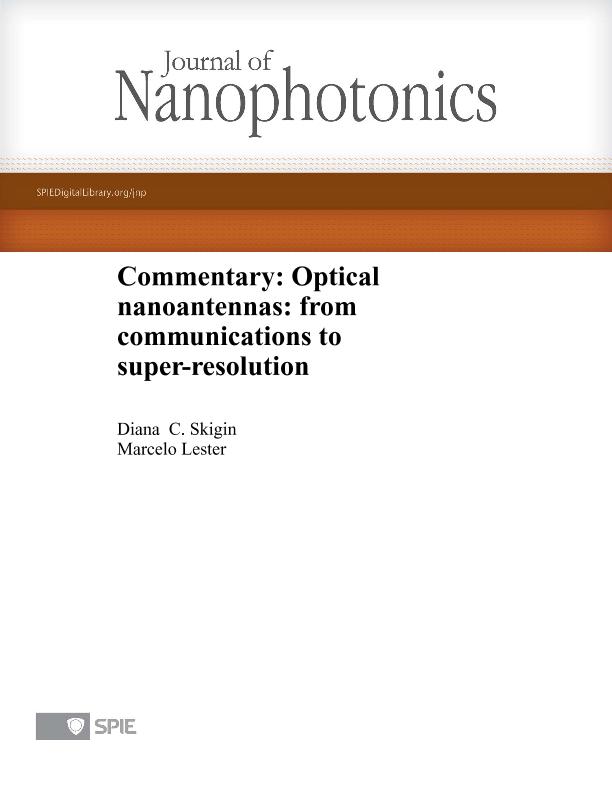Mostrar el registro sencillo del ítem
dc.contributor.author
Skigin, Diana Carina

dc.contributor.author
Lester, Marcelo Fabian

dc.date.available
2018-08-27T15:40:44Z
dc.date.issued
2011-06
dc.identifier.citation
Skigin, Diana Carina; Lester, Marcelo Fabian; Commentary: Optical nanoantennas: From communications to super-resolution; Society of Photo-Optical Instrumentation Engineers; Journal Of Nanophotonics; 5; 1; 6-2011; 1-4
dc.identifier.issn
1934-2608
dc.identifier.uri
http://hdl.handle.net/11336/57183
dc.description.abstract
As silicon is the basis of conventional electronics, so strontium titanate (SrTiO3) is the foundation of the emerging field of oxide electronics1,2. SrTiO3 is the preferred template for the creation of exotic, two-dimensional (2D) phases of electron matter at oxide interfaces3–5 that have metal–insulator transitions6,7, superconductivity8,9 or large negative magnetoresistance10. However, the physical nature of the electronic structure underlying these 2D electron gases (2DEGs),
which is crucial to understanding their remarkable properties11,12, remains elusive. Here we show, using angle-resolved photoemission spectroscopy, that there is a highly metallic universal 2DEG at the vacuum-cleaved surface of SrTiO3 (including the non-doped insulating material) independently of bulk carrier densities over more than seven decades. This 2DEG is confined within a region of about
five unit cells and has a sheet carrier density of 0.33 electrons per square lattice parameter. The electronic structure consists of multiple subbands of heavy and light electrons. The similarity of this 2DEG to those reported in SrTiO3-based heterostructures6,8,13 and field-effect transistors9,14 suggests that different forms of electron confinement at the surface of SrTiO3 lead to essentially the same
2DEG. Our discovery provides a model system for the study of the electronic structure of 2DEGs in SrTiO3-based devices and a novel means of generating 2DEGs at the surfaces of transition-metal oxides
dc.format
application/pdf
dc.language.iso
eng
dc.publisher
Society of Photo-Optical Instrumentation Engineers

dc.rights
info:eu-repo/semantics/openAccess
dc.rights.uri
https://creativecommons.org/licenses/by-nc-sa/2.5/ar/
dc.subject
Nanoantennas
dc.subject
Plasmonics
dc.subject
Optical Resonances
dc.subject.classification
Nano-materiales

dc.subject.classification
Nanotecnología

dc.subject.classification
INGENIERÍAS Y TECNOLOGÍAS

dc.title
Commentary: Optical nanoantennas: From communications to super-resolution
dc.type
info:eu-repo/semantics/article
dc.type
info:ar-repo/semantics/artículo
dc.type
info:eu-repo/semantics/publishedVersion
dc.date.updated
2018-08-24T13:34:36Z
dc.journal.volume
5
dc.journal.number
1
dc.journal.pagination
1-4
dc.journal.pais
Estados Unidos

dc.journal.ciudad
Washington
dc.description.fil
Fil: Skigin, Diana Carina. Universidad de Buenos Aires; Argentina. Consejo Nacional de Investigaciones Científicas y Técnicas. Oficina de Coordinación Administrativa Ciudad Universitaria. Instituto de Física de Buenos Aires. Universidad de Buenos Aires. Facultad de Ciencias Exactas y Naturales. Instituto de Física de Buenos Aires; Argentina
dc.description.fil
Fil: Lester, Marcelo Fabian. Universidad Nacional del Centro de la Provincia de Buenos Aires. Facultad de Ciencias Exactas. Instituto de Fisica Arroyo Seco; Argentina
dc.journal.title
Journal Of Nanophotonics

dc.relation.alternativeid
info:eu-repo/semantics/altIdentifier/doi/http://dx.doi.org/10.1117/1.3595688
Archivos asociados
